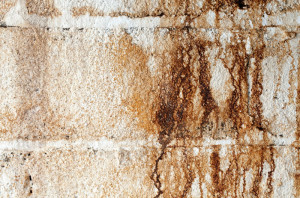While the bricks and mortar of your chimney is designed to withstand the elements, there is one force that can cause serious damage – water. Moisture can wreak havoc throughout your chimney system, causing leaks, rusty parts, and masonry deterioration. However, the presence of moisture can also show itself in unique ways, including chimney discoloration or staining. The following guide can help you identify the kind and source of your chimney staining – as well as how you can keep it from coming back in the future.

Red or brown stains
If you have a prefabricated or factory built chimney, red or brown stains on the chimney chase are often the result of rusting. Long-term exposure to moisture – especially from puddles of standing water – can cause the galvanized metal found in many chimney chase covers to deteriorate and rust. The rusting chase top then causes dark red, brown, or orange staining to appear on the sides of the chimney. Rusted chase covers should be replaced with sturdier metals such as stainless steel or copper to prevent rusting from occurring again.
White stains
Crystalline or powdery white stains or discoloration are caused by a phenomenon known as efflorescence. Efflorescence occurs when water trapped in the masonry evaporates, leaving behind a concentration of white mineral salt.
Efflorescence is more commonly seen in areas where ground or rain water has a high salt content. Water from hoses, sprinklers, or rain can all cause efflorescence to occur. However, interior efflorescence may indicate that you have a leaky chimney; only small amounts of moisture are required to leave behind the mineral white chalky salt after evaporation.
Dark green stains
Dark green stains or discoloration is typically caused by the growth of algae on masonry. In order for this type of discoloration to occur, water must continually flow or pool over one area of the chimney structure. This type of long term exposure to moisture can foster an environment for algae growth – as well as mold or mildew – on the chimney.
What about inside?
While water can wreak havoc on your masonry outside, it can cause an equal number of problems indoors as well. One of the most common signs of a chimney leak is the presence of water in the flue, firebox, or on surrounding walls or ceilings. However, it can be difficult to tell the difference between a roof leak and a leaky chimney; because of this, you may want to have a certified chimney sweep have a look at the chimney before you or your insurance company pay to have the roof inspected and repaired.
Staining on your masonry could indicate that your chimney has a water leak. For more information on identifying chimney stains or to schedule a chimney inspection, contact Lords Chimney today!
When stains appear on the sides of a chimney, many homeowners falsely assume it is a natural part of an aging chimney. Unfortunately, chimney discoloration is often more than just a simple eyesore. Chimney stains and discoloration may indicate the presence of damage or other problems. The following are five of the most common kinds – and causes – of chimney discoloration.

Black stains
Black stains on interior masonry are caused by soot buildup. Soot staining is often the sign of a chimney that has not been properly cleaned or maintained. Likewise, soot stains can also be caused by burning the wrong materials, such as green wood or paper and cardboard.
While soot stains are relatively common on older masonry chimneys, gas fireplaces should never have soot stains. Soot stains, especially those around the top of the chimney, indicate that there is a problem with the gas fireplace and the fuel is not burning correctly; soot staining on gas fireplaces can sometimes indicate a carbon monoxide leak.
Brown/black stains
Brown and black staining around the chimney cap or down the sides of the chimney structure is one of the most common kinds of chimney stains. While most homeowners assume this kind of discoloration is simply staining from soot, it is typically caused by excessive creosote buildup in the flue. If a chimney is not regularly swept, creosote can build up to the point where runoff stains the top and sides of the chimney. Because creosote staining is so similar to soot staining, a chimney sweep may be needed to evaluate the difference between the two.
Green stains
Green or dark green discoloration on a chimney is caused by the growth of mold and algae. This kind of green staining is most commonly seen in areas where water directly flows. Chimneys without a lip on the chimney crown may be particularly susceptible to algae or mold growth as the water travels over the masonry.
Red/brown stains
Red and brown rust stains are almost exclusively seen with prefabricated or metal chimneys. Because factory build chimneys have metal chase covers, they are prone to rusting. When this occurs, dark brown, red, and orange rust stains will begin to streak down the sides of the chimney chase. If rust staining is noticed, the chimney should be inspected immediately for signs of water damage caused by a chimney leak.
White stains
White stains on masonry structures are known as efflorescence. As water in the brick evaporates, it leaves behind mineral salt which then creates powdery white or crystalline discolorations on the masonry of the chimney. Exterior efflorescence is usually harmless and caused by ground or rain water. However, interior efflorescence may indicate the presence of a chimney leak.
Chimney stains do more than just affect your home’s curb appeal; they can also indicate the presence of a serious chimney problem. Schedule an appointment with Lords Chimney today to find out if your chimney discoloration is cosmetic or caused by something more serious.



